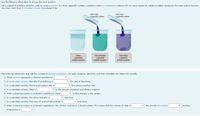
Chemistry
10th Edition
ISBN: 9781305957404
Author: Steven S. Zumdahl, Susan A. Zumdahl, Donald J. DeCoste
Publisher: Cengage Learning
expand_more
expand_more
format_list_bulleted
Question
Can you please answer this and give a explanation if possible?

Transcribed Image Text:Use the following information to answer the next question.
Solid copper(II) sulfate is added to water to make a solution (1). More copper(II) sulfate is added to make a concentrated solution (II). As more copper(II) sulfate is added, eventually the water cannot dissolve
any more solid; thus, a saturated solution is produced (III).
add more
copper(Il) sulfate
add more
copper(Il) sulfate
Dilute
Concentrated
Saturated
copper(l)
sulfate solution
copper(ll)
sulfate solution
copper(Il)
sulfate solution
The following statements deal with the concept of dynamic equilibrium. For each sentence, select the word that completes the statement correctly.
1. Which solution repre
ents a dynamic equilibrium?
2. In a saturated solution, the rate of crystallizing is
• the rate of dissolving.
3. In a saturated solution, the forward reaction rate is
the reverse reaction rate.
4. In a saturated solution, there is
* in the amount of product and starting material.
5. When a chemical system is at dynamic equilibrium, there
visible changes in the system.
6. In a saturated solution, the colour intensity is
over time.
7. In a saturated solution, the mass of undissolved particles is
over time.
8. When a chemical system is at dynamic equilibrium, the solution must be in a closed system. This means that the volume of water is
the amount of solute is
and the
temperature is
Expert Solution
This question has been solved!
Explore an expertly crafted, step-by-step solution for a thorough understanding of key concepts.
Step by stepSolved in 2 steps

Knowledge Booster
Learn more about
Need a deep-dive on the concept behind this application? Look no further. Learn more about this topic, chemistry and related others by exploring similar questions and additional content below.Similar questions
- The protein glycophorin A has a sugar group covalently attached to it. It is an example of a de ce à glycoprotein metalloprotein hemoprotein lipoprotein nucleoprotein Ophosphoproteinarrow_forwardComplete the following reactions and hence identify the nature of the acid-base interaction and the name associated with acid-base interaction that you have chosen. Q1. (a) H30* + OH >arrow_forwardProtein sequence is always read (blank) terminal to (blank) terminal. And DNA sequence is always read (blank) prime to ( blank) prime. I need help filling in the blanks please? ? Thanksarrow_forward
- Which molecule is a complete organic molecule (i.e. all atoms are shown correctly)? A H. c=C–C= C–H H C H. C=C-C-C-H | H. H. C H. C- D H. нн . C С —С—Н C=C–C- C-H H H. ОН Н А I-0-I エーO I-Ú-I I-U-I I-U-I エー○arrow_forwardShown here is a tripeptide, which consists of three amino acids linked together in a chain. Circle and name each amino acid. HO H,N HOarrow_forwardat a pH value of 2, the amino and carboxyl groups in an amino acid will exist asarrow_forward
- Please help me with the following 1) sketch a phosphodiester bond 2) Make the two amino from the image below. And contrast the polarity of the side chainsarrow_forwardAmino acids are synthesized by plants to store nitrogen. True or false.arrow_forwardThe name carbohydrate comes from the fact that many simple sugars have chemical formulae that look like water has simply been added to carbon. (The suffix hydrate from the Greek word hydor ("water") means "compound formed by the addition of water.") The actual chemical structure of carbohydrates doesn't look anything like water molecules bonded to carbon atoms (see sketch at right). But it is nevertheless possible to chemically extract all the hydrogen and oxygen from many simple carbohydrates as water, leaving only carbon behind. If you search the Internet for "reaction of sulfuric acid and sugar" you will find some impressive videos of this. Suppose you had 300.g of ordinary table sugar, which chemists call sucrose, and which has the chemical formula C12H22O11 . Calculate the maximum mass of water you could theoretically extract. Be sure your answer has a unit symbol, and round it to the correct number of significant digits.arrow_forward
arrow_back_ios
SEE MORE QUESTIONS
arrow_forward_ios
Recommended textbooks for you
 ChemistryChemistryISBN:9781305957404Author:Steven S. Zumdahl, Susan A. Zumdahl, Donald J. DeCostePublisher:Cengage Learning
ChemistryChemistryISBN:9781305957404Author:Steven S. Zumdahl, Susan A. Zumdahl, Donald J. DeCostePublisher:Cengage Learning ChemistryChemistryISBN:9781259911156Author:Raymond Chang Dr., Jason Overby ProfessorPublisher:McGraw-Hill Education
ChemistryChemistryISBN:9781259911156Author:Raymond Chang Dr., Jason Overby ProfessorPublisher:McGraw-Hill Education Principles of Instrumental AnalysisChemistryISBN:9781305577213Author:Douglas A. Skoog, F. James Holler, Stanley R. CrouchPublisher:Cengage Learning
Principles of Instrumental AnalysisChemistryISBN:9781305577213Author:Douglas A. Skoog, F. James Holler, Stanley R. CrouchPublisher:Cengage Learning Organic ChemistryChemistryISBN:9780078021558Author:Janice Gorzynski Smith Dr.Publisher:McGraw-Hill Education
Organic ChemistryChemistryISBN:9780078021558Author:Janice Gorzynski Smith Dr.Publisher:McGraw-Hill Education Chemistry: Principles and ReactionsChemistryISBN:9781305079373Author:William L. Masterton, Cecile N. HurleyPublisher:Cengage Learning
Chemistry: Principles and ReactionsChemistryISBN:9781305079373Author:William L. Masterton, Cecile N. HurleyPublisher:Cengage Learning Elementary Principles of Chemical Processes, Bind...ChemistryISBN:9781118431221Author:Richard M. Felder, Ronald W. Rousseau, Lisa G. BullardPublisher:WILEY
Elementary Principles of Chemical Processes, Bind...ChemistryISBN:9781118431221Author:Richard M. Felder, Ronald W. Rousseau, Lisa G. BullardPublisher:WILEY

Chemistry
Chemistry
ISBN:9781305957404
Author:Steven S. Zumdahl, Susan A. Zumdahl, Donald J. DeCoste
Publisher:Cengage Learning

Chemistry
Chemistry
ISBN:9781259911156
Author:Raymond Chang Dr., Jason Overby Professor
Publisher:McGraw-Hill Education

Principles of Instrumental Analysis
Chemistry
ISBN:9781305577213
Author:Douglas A. Skoog, F. James Holler, Stanley R. Crouch
Publisher:Cengage Learning

Organic Chemistry
Chemistry
ISBN:9780078021558
Author:Janice Gorzynski Smith Dr.
Publisher:McGraw-Hill Education

Chemistry: Principles and Reactions
Chemistry
ISBN:9781305079373
Author:William L. Masterton, Cecile N. Hurley
Publisher:Cengage Learning

Elementary Principles of Chemical Processes, Bind...
Chemistry
ISBN:9781118431221
Author:Richard M. Felder, Ronald W. Rousseau, Lisa G. Bullard
Publisher:WILEY